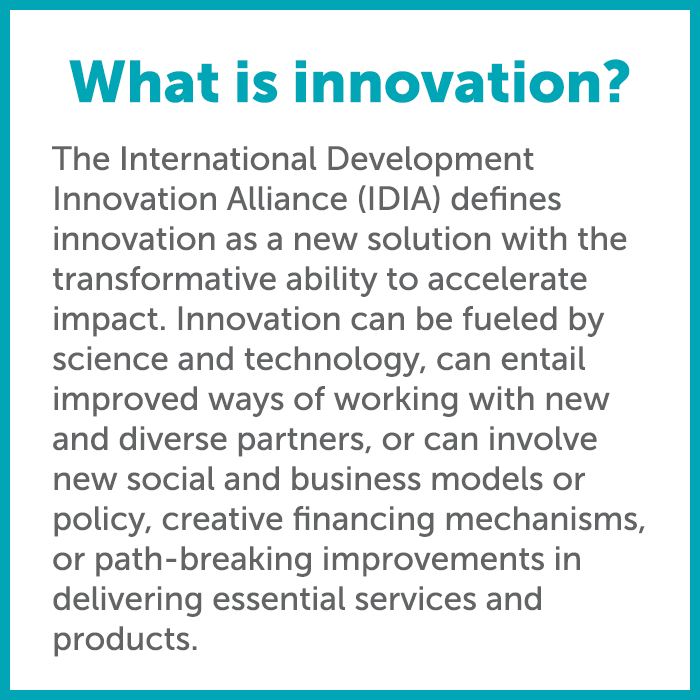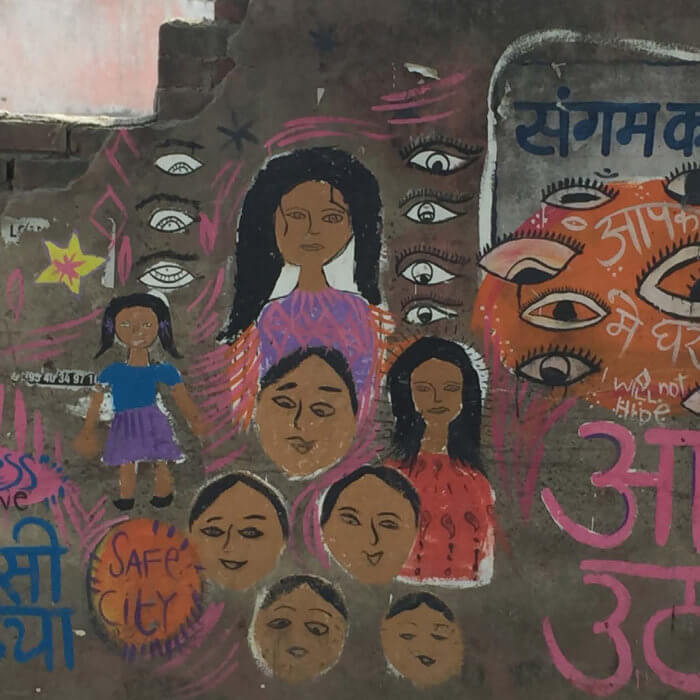Exploring innovations to address a shadow pandemic
Preventing gender-based violence
[Editor’s note: R4D serves as the secretariat to the International Development Innovation Alliance (IDIA), which promotes innovation as a critical approach to delivering sustainable, scalable solutions. IDIA’s Gender & Innovation Working Group collaborated to identify innovative approaches, partners and solutions to advance gender equality, presented in this collection “Innovating to Address Gender-Based Violence.”]
Globally, 243 million women and girls have experienced violence in the last 12 months by an intimate partner, which UN Women describes as the “shadow pandemic of COVID-19.” The WHO adds that 1 in 3 women experience violence in their lifetimes and this is now further exacerbated by COVID-19.
As a former telecommunications engineer interested in challenging problems, I wanted to know why this is the case. Gender equality is an area I’ve been passionate about since attending the 4th World Conference for Women in Beijing in 1995. I was in China working to develop the nation’s backbone telecommunications system and as a member of Women at AT&T and one of few women engineers at that time, I thought that any organization interested in the advancement of women should attend the conference. So, I petitioned to attend and represent AT&T. In the 25 years since this conference, I can’t help but wonder, have we fully applied our vast technical capabilities, our commitment to the Sustainable Development Goals (SDGs), our creativity and talents to achieve SDG 5 (gender equality) — and what would happen if we did?
Progress to achieve SDG 5 has been slow. Despite the fact that gender equality and the empowerment of women and girls has been proven to successfully boost outcomes across all the SDGs, change has been insufficient in addressing the structural root causes of women and girls’ inequality, which include unfair social expectations, legal discrimination, and low levels of political participation. While there have been improvements in a few areas, we still have not achieved gender equality in schools, national parliaments (on average 25% are elected women), or even in simply establishing laws to end domestic violence against women (49 countries have none, and even more have trouble enforcing them).
In the face of such odds, how might we use innovation to advance gender equality and tackle this shadow pandemic of gender-based violence (GBV)? Below, I’ll share seven innovation approaches that are critical to accelerating progress across the SDGs.
Change is Possible — Innovation promises to accelerate progress
Gender equality is critical to sustainable development. And achieving this real gender-transformational change requires innovation. The good news is members of the International Development Innovation Alliance (IDIA) — a global alliance of leading bilateral, multilateral, and philanthropic organizations — are committed to working toward this goal. In 2018, gender and innovation specialists from IDIA joined with civil society partners to explore the connection between gender and innovation, the collaboration resulted in the toolkit Towards Bridging Gender Equality & Innovation, which integrates these two cross-cutting approaches. Global Affairs Canada led the way, with its Feminist International Development Assistance policy, and as part of R4D’s Innovation Practice and the Secretariat of IDIA, I was lucky enough to facilitate this work.
In 2019 and 2020, we explored how innovation could be applied to gender programs given that many development challenges are underserved by innovation. Specifically, we set out to identify innovative approaches, partners, or solutions that could be transformative in addressing one of the most widespread and persistent human rights violations — gender-based violence. What we found is a work in in progress and we encourage others to learn from the innovative approaches uncovered, whether from the perspective of health, education or other areas of sustainable development.
Members of the group reached out to their networks to surface innovative approaches or partnerships that showed evidence of impact or had the potential for transformative change. The Global Innovation Exchange (GIE) was also employed to search for relevant solutions using its database of more than 16,000 innovations.
A collection of 60+ innovative solutions and partnerships were uncovered and are presented in the resulting paper “Innovating to Address Gender-Based Violence”. While this collaborative process revealed a range of approaches being used to deal with GBV, the number of innovations was by no means as large as the group had hoped, nor scaled enough to make significant systemic changes that we’d like to see. Still, we hope this collection will serve as a catalyst for all of us who care about the well-being of girls and women to develop, refine, adopt, and scale more innovations that help speak to the deep-rooted causes of gender inequality.
7 approaches to inspire innovation

We identified seven categories or approaches to innovation that underpin efforts of actors globally — in this case to advance gender equality — but which can be applied to any complex development challenge. What we found is a work in in progress and we encourage others to learn from the innovations uncovered and build upon these approaches. Whether tackling gender inequality from the perspective of health or education or addressing other development challenges — these approaches are meant to provide a better understanding of innovation. They are not meant to limit or dictate the use of innovation as an approach, but instead provide examples of processes, methods or mindsets that have enabled progress toward a solution.
To encourage further innovation, we unpack the approaches here.
- Innovative approaches that prevent or respond to GBV through service delivery, institutional change efforts, or those that speak to unconscious bias using human-centered design processes, or that adapt innovations from other sectors and apply them to promote gender equality. (E.g., See MediCapt, an app which connects medical and legal professionals to transform prosecution of human rights violations, changing institutions and service delivery through technology.)
- Behavioral insights that involve new ways to apply knowledge regarding the way people and organizations behave under certain sets of conditions. For example, to shift problematic norms, attitudes, or power relations. (E.g. See Right to Play, as school-based sport and play program, shifting norms and challenging acceptability of violence against women and girls.)
- Technological innovations that prevent or respond to GBV in terms of programs, services, or data, which might make use of AI, open source, or emerging technologies. (E.g. See Deaf Outreach Programme that uses tech to reach out to, educate and build a community of deaf individuals and attend to GBV.)
- Innovative partnerships that involve different methods of collaborating with new or existing stakeholders to co-create solutions with insights from GBV experts/survivors and civil society organizations. (E.g. See the UNICEF-Criterion Institute Partnership, which brings together two systems that rarely interact—finance and GBV.)
- Policy innovations that identify new ways to design, implement, and evaluate policies, or that confront problematic institutional norms and legal gaps in laws with regard to GBV. (E.g. See Care India, which targets incomplete implementation of national laws for health systems.)
- Creative business models that provide sustainable financing, partner with investors, or apply scaling models used in other areas to GBV programming. (E.g. See Planning and Paying for Local Action Plans to Address GBV.)
- Pioneering research that involves new methods, cross-disciplinary/sectoral approaches, or designed to extend research and data sets by amount, type, accuracy, context, complexity, population studied, or sector. (E.g. See Primero, an open source technology that standardizes data collection for child protection and GBV.)
In particular, IDIA encourages developing policy innovations that have the potential to positively impact large populations, and creative business models that will sustainably finance interventions to prevent and respond to GBV.
A call to action
We can all agree that far more needs to be done to build stronger systems and pipelines that can advance gender equality and tackle the issue of GBV. This includes scaling transformative innovations as well as adapting and developing new solutions. Resources also need to be mobilized to support and scale innovations in underserved areas and regions.
Beyond addressing human rights violations, we know preventing GBV is transformational. It improves the health of women and children, increases economic productivity, and advances educational attainment among other benefits. With the rise of violence and inequality seen under the coronavirus, we hope this collection will encourage shifts in problematic norms the use of creative, open or frugal innovations that prevent GBV, and result in visionary ways of working to develop policies, institutions, and capacities that promote gender equality.
You are invited to learn from, build upon, and apply these innovative approaches to other development challenges. It is the hope of the International Development Innovation Alliance that development actors world-wide will be inspired to creatively innovate in pursuit of gender equality.
This paper, “Innovating to Address Gender-Based Violence,” presents the collection of innovations, which have been added to the Global Innovation Exchange (GIE). We invite others to grow this body of global knowledge by sharing the innovative approaches used address the complex challenge of GBV. (To contribute, contact partners@globalinnovationexchange.org or learn more by contacting IDIA at fkhan@r4d.org).














